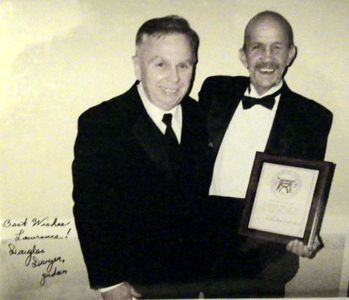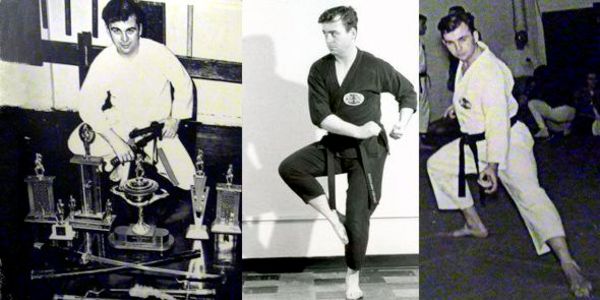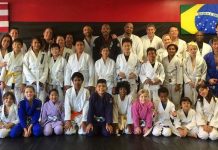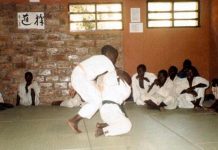We were greeted by Grandmaster Lawrence Day. He received each of us with a warm handshake and welcomed us to the venue. We had come to see Grand Master Doug Dwyer, a true martial arts legend of the early days American Karate. He had graciously agreed to share some of his great wisdom and experience with us. He had trained with all the pioneers of the USKA and honed his skills on the mean streets of sixties Chicago. Later, he trained soldiers and law enforcement in the deadly arts of the empty hand. After decades of teaching he had retired, but he never stopped training. Now he had come to visit his old friend and speak to the master’s class. Both had been students of John Keehan.
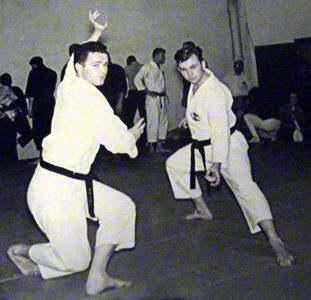
Keehan and Robert Trias had founded the United States Karate Association. The first national board of martial arts review, sanction and sponsorship. They organized tournaments and events all over the country and virtually introduced Karate to the American public. Keehan almost single-handedly brought martial arts to the Midwest in the nineteen sixties.
After WWII there was a great deal of interest in Oriental martial arts. American soldiers had been exposed to Judo on the battlefields of the Pacific in mortal hand-to-hand combat. They had returned and began to train others in these mysterious “arts” with their odd rituals and rigid training methods. Part of Judo is Atemi-Jitsu, striking or kicking the opponent, usually as a pre-cursor to unbalance him for a throwing technique. But, there was also a system that relied almost exclusively on striking to overcome the opponent, it was called “kara-te” the Way of the Empty Hand. It was a closely guarded and hidden secret for centuries But, as with Judo, Westerners eventually found teachers who would show them the secrets of breaking bricks with their bare hands or killing a bull with a Hammer Fist to the skull. And they studied and learned and came home to teach others these deadly skills.
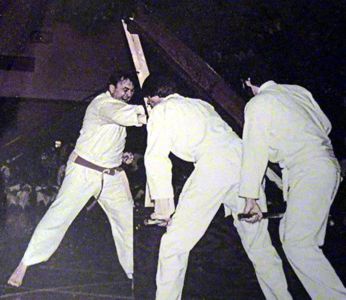
Sport Karate in the sixties was a far cry from what it is today. Before safety pads were added to the competition Karateka were required to have absolute control of their techniques, for indeed, they had the power of life and death in their hands. Even so, there were many injuries, but the teachers, the true Sensei, knew how to deal with dislocated shoulders or broken fingers, because that too was part of their training. Nor did they limit themselves to just Karate. Judoka were allowed to use their throwing techniques. Even wrestlers and those self-taught on the streets in eclectic styles could employ a wide variety of techniques. All of which made these early events spectacular displays of skill and ability because they were essentially the first No Holds Barred competitions of their type held in the United States.
They included demonstrations of “kata,” formalized exercises of punching and kicking techniques designed to teach the student not only the deadly striking techniques, but also to develop balance, speed, strength and “form,” or dynamic presentation style. And Tamieshiwara, breaking of hard objects with the hand as a method of showing the lethal power of the techniques that was possible with training and practice. No one had ever seen these such things before. Grandmaster Dwyer was himself famous for splintering two-by-four boards with his empty hand strikes.
Dr. Day provided instruction in Dim Mak and showed us his recently published book, not available to the general public. It was filled with detailed charts of the anatomy and striking points for the secret and forbidden Death Touch as well as explanations and timetables for determining the most effective time and direction to apply pressure or force to devastate any opponent. Many claim to know these secrets, but few can explain them adequately. Grandmaster Day’s text is reserved only for his senior students, many of whom have trained with him for fifteen or more years. Thus insuring that he knows well their character. Such knowledge is not shared lightly. First, the teacher must be assured that it will not be misused. Second, because the practice requires great patience and practice. Not many students have enough of either. With great power such as this, comes great responsibility. The taking of a life does no one honor. It is the small and subtle that prevails over force and brutality.
He told us of how he had come by this knowledge. How training with John Keehan and Grandmaster Doug Dwyer had set him on this path of adventure and learning. And indeed, what a wonderful life it had been. We heard the true history of how it had come to be and what had happened from one who had been there and done it all and knew the real story.
We were presented with badges for our uniforms, symbolically inducting us into his Dojo and making us privy to this information. One for the original martial arts fraternity founded by Keehan after leaving the USKA. And one for the new 21st century international organization.
The pavilion was large and near the waterfront. Set back away from the road for privacy and large enough to accommodate those who had gathered for the afternoon class. The wooden picnic tables had been pushed to the sides to make room for the group. The air was cool and crisp as we bowed crossing the threshold and were introduced to Grandmaster Doug Dwyer. He was chatting with some of Dr. Day’s students when we arrived, preparing for his presentation. His warm smile and bright eyes assured us of his sincerity. His firm handshake was a sign of his fitness and strength. He wore a white ghi with only a few patches and a red belt, the mark of a 10th Dan Grandmaster. A degree earned only after decades of training and teaching and practicing. With more than fifty years time in grade, and the fact that his very posture and movements made you aware of his balance and potential for explosive movement, it was obvious he was worthy of the respect due this grading.
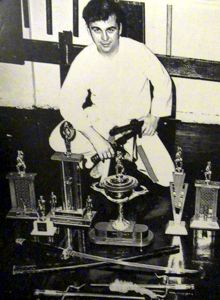
We began with stretching out exercises. Shifting from side to side to loosen the ligaments and get the blood flowing, twisting the torso to limber up. Sensei then illustrated a unique stepping drill. Beginning in Tsuru Ashi Dachi, One Legged Stance, with one foot resting lightly on the inside of the opposite knee, we would first step forward with the upraised leg to advance, using the foot and shin in a circular motion to deflect any attack to the groin. Upon setting the foot down, the trailing foot would then be quickly drawn up to rest against the inside of now forward leg. We practiced this for a time, making corrections as needed. Then moved on to the next level by making not a circular step forward, but rather hopping quickly from one leg to the other, each time bringing the rear leg quickly up to the opposite knee. This, Sensei explained is a method of developing stepping skill, so that at any time you can skip to either side, off the line of engagement and away from your opponent’s attack. While simultaneously closing the distance between you and placing yourself in position to deliver a counter-strike from a protective stance at a difficult angle for the enemy to defend.
Grandmaster Doug Dwyer illustrated next several blocking methods, all of which were made more effective by the simple addition of drawing the technique toward your own centerline. This subtle enhancement, very similar to drawing the sword toward yourself when executing a proper cut, adds a dynamic dimension to even the most basic block. In sport karate, for example, the Chudan or middle-block describes a quarter circle arc in front of the torso to deflect any attack to the chest, ending with the elbow bent and near the body with the fist directly in front of the shoulder. By executing this same motion with a whipping action and striking the opponent’s radial or ulnar nerve with the Trapezium, a small bone at the base of the thumb just above the wrist, it is possible to inflict quite a stunning blow that will paralyze the arm and disable the opponent. By adding the subtle movement of pulling backward at the same time, almost like the recoil of a bullwhip, the opponent can be pulled forward, breaking his balance with his own punch, into you for a follow-up strike with the same or opposite hand without the need to grab his wrist and pull him to you. This, Sensei explained, is one of the great dangers of over-extending or reaching with your punch. The fist should not be thrown so far that the arm is locked out nor the balance broken. This was one of the themes for the class. Get the opponent in close so that you can deliver a more powerful blow using these subtle points of balance and leverage. An example of this were the Morote-Uke techniques using both hands to bring the opponent down and forward for a knee strike kick to the join double duty kick.
The sun had set long ago, but we trained until it was getting dark. Those who were recording hadn’t complain about the conditions. In fact, not all of the instructions would be taped. It was tradition that the advanced teachings of the next day should only be passed from master to student.
We adjourned for dinner. Our hosts had chosen a large banquet room at a well known local restaurant. We ate well and plenty, enjoying the fellowship of new friends and brother martial artists. After dinner we split up into separate groups. Some came back to the hotel with us. We chatted and exchanged views on martial arts well into the night. Laughing and joking and telling tales of our own adventures. Watching videos downloaded from YouTube. Commenting on skill or lack of or arrogance by some who had posted there. Real martial artists are not rigid or stern. They are like water. As Grand Master Dwyer had pointed out that very evening, “You must make you motions fluid.” Relaxing, letting the action lead you, only tensing at the moment of impact for maximum effect. In this way you increase your stamina and do not tire yourself out.
25 October-Saturday
The next morning we assembled at the private Dojo of 7th Dan Black Belt Joseph Cayer. A variety of schools and styles were represented by their Sensei or senior students, Black Belts all. There to learn from the venerable masters the dozen or so ritual exercises or dances of death that had made them famous and allowed them to remain virtually undefeated for more than a generation. Before the class began one of the visitors, Grandmaster David harris, quietly circulated among the attendees, speaking softly with them and quietly relieving any stiffness from the previous day’s workout, as well as healing many old wounds and painful conditions with Chi Kung.
Grandmaster Doug Dwyer became fast friends with another guest martial artist, Barron Shepherd, who had been invited by Grandmaster Day to receive his 7th Dan certification as Master Instructor, and Master’s Council Accreditation, both personally signed by Grandmaster Doug Dwyer.
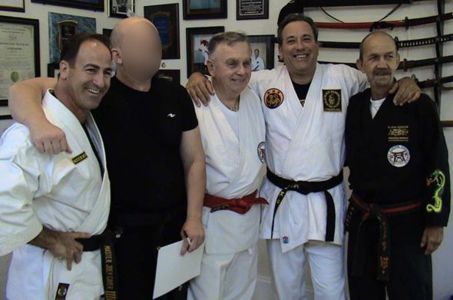
The class began with traditional Zen meditation and kneeling bow. After a few warm-up exercises Sensei handed out the weights. These were bags filled with lead shot weighing about five pounds that were attached to the wrist with buckles or velcro. When those ran out, five pound dumbbells were used to add weight to hand and arm. We practiced blocking and punching wearing these to develop control and power. Sensei demonstrated several times his ability to throw a full power, close-in, short range, devastating techniques within millimeters of vital and fatal points of his demonstrator’s body at full speed, without inflicting any injury. Practicing with weights was the method to develop this control. Control that was essential to the next phase of this special and secret training. There were five classes in all over the next two days.
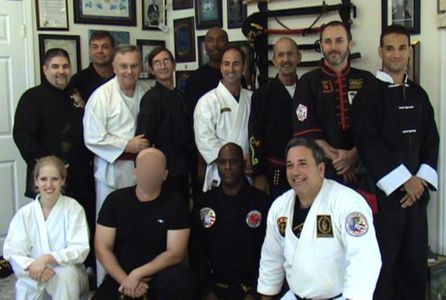
At the conclusion of the seminar, I was greatly honored to be recognized as a true member of the martial arts fraternity and advanced to the rank of 10th Dan Grandmaster in the secret and forbidden arts. We were presented with certificates of advancement and graduation and copies of the original training manual from 1968 written by John Keehan and Grandmaster Dwyer personally signed by Grandmaster Doug Dwyer and Grandmaster Day. For this wonderful experience I cannot thank Grandmaster Day and his associates enough for their warm hospitality and great kindness. We look forward to seeing all again at the Martial Arts Hall of Fame Headquarters in Nashville in July next year.
